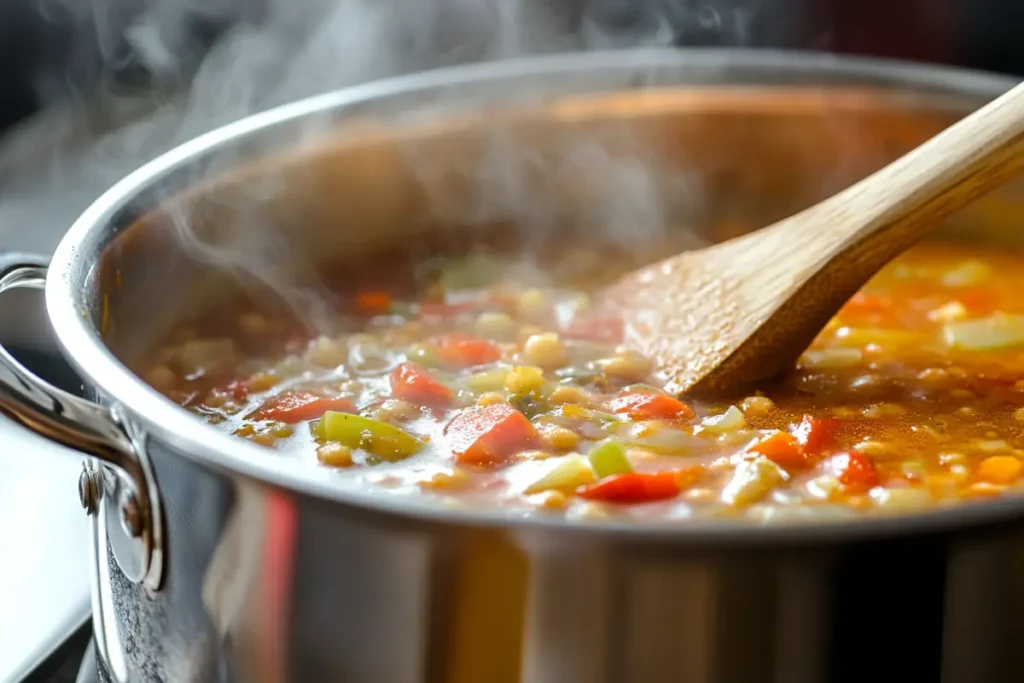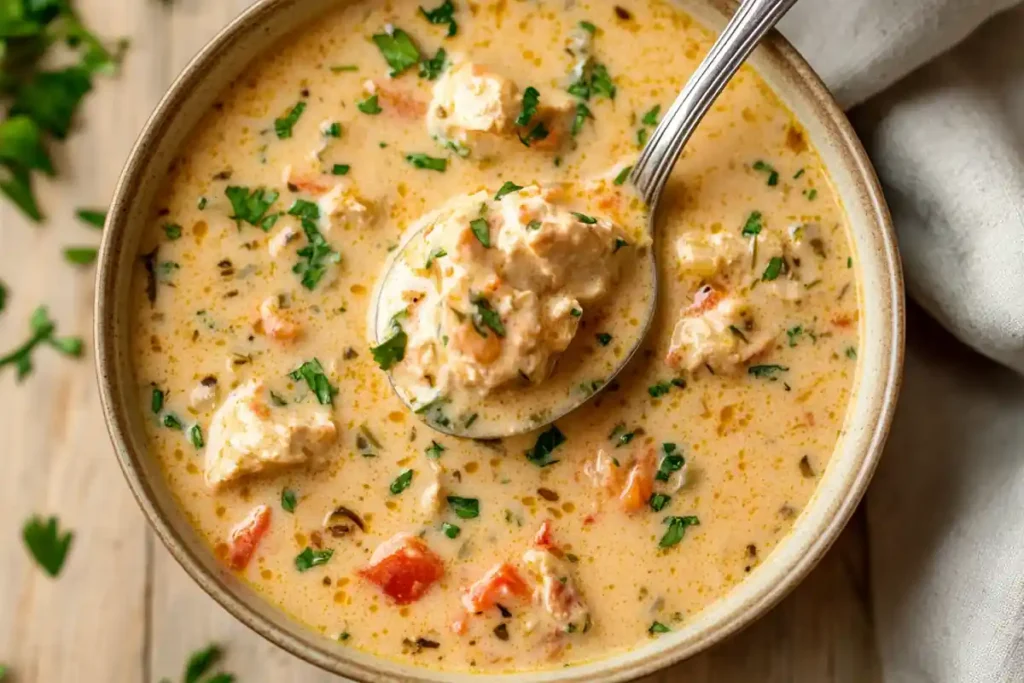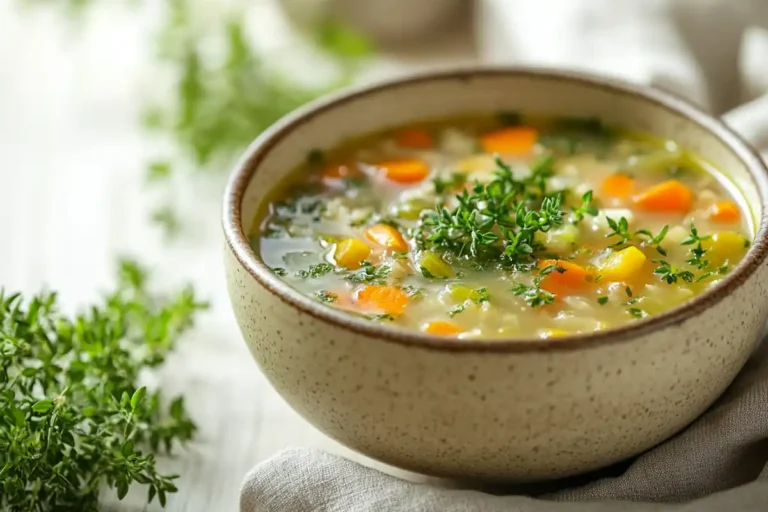Growing up with food allergies taught me that comfort food isn’t about restriction—it’s about creativity. Those chilly evenings when a warm bowl of soup could make everything better sparked my passion for gluten free soup recipes. These recipes don’t compromise on taste or nutrition.
Navigating the world of healthy soup recipes can feel overwhelming, especially when gluten sensitivity enters the picture. But here’s the exciting truth: gluten free soups are not just possible—they’re incredibly delicious. Whether you’re managing celiac disease or simply exploring new culinary horizons, this guide will transform your kitchen into a sanctuary of flavor.
Imagine savoring rich, hearty soups that warm your soul without worrying about hidden gluten triggers. From creamy potato leek to robust vegetable medleys, gluten free soup options are more exciting and accessible than ever before. We’ll explore techniques, ingredients, and recipes that prove dietary restrictions never mean sacrificing enjoyment.
Your journey to mastering gluten free soup starts here—where comfort meets nutrition, and every spoonful tells a story of culinary innovation.
Understanding Gluten Free Soup Basics
Exploring gluten-free soups can be tricky, especially for those with dietary needs. It’s important to watch what you put in your soups. This ensures they are safe and tasty.
To make safe soups, first learn about gluten sources. Not all soups are gluten-free. Knowing which ingredients are safe is key.
Common Sources of Hidden Gluten in Soups
Gluten can sneak into soups in unexpected ways. Be aware of these common culprits:
- Wheat-based thickeners
- Barley malt flavoring
- Modified food starch
- Roux (flour-based sauce)
- Certain bouillon cubes
Essential Ingredients for Gluten Free Soups
To make great gluten-free soups, use these safe ingredients:
| Ingredient Category | Gluten-Free Options |
| Grains | Rice, quinoa, corn, millet |
| Thickeners | Cornstarch, potato starch, arrowroot |
| Protein | Chicken, beef, fish, legumes |
Reading Labels and Safety Tips
To avoid gluten, be careful with what you buy. Always:
- Read ingredient labels carefully
- Look for certified gluten-free labels
- Contact manufacturers with questions
- Use separate cooking utensils
Pro tip: When in doubt, choose whole food ingredients and prepare soups from scratch. This way, you get the best safety and flavor.
Top Brands Offering Certified Gluten Free Soup Options
Finding gluten free soups can be tough. You want them to be easy to find, taste great, and fit your diet. Luckily, many well-known brands now offer gluten free soups that are full of flavor.
So, are any Campbell’s soups gluten free? Yes, they are! Campbell’s has grown their gluten free soup line. They make it easy to spot the gluten free ones by clearly labeling them.
- Campbell’s Select Harvest line offers multiple gluten free options
- Look for clear gluten free labeling on packaging
- Check ingredient lists carefully
Progresso has also joined the gluten free market. Is Progresso soup gluten free? Yes, many of their soups now have gluten free certification. Always double-check labels, as ingredients can change.
Looking for tin soups that are gluten free? Here are some top brands to consider:
| Brand | Gluten Free Options | Certification |
| Campbell’s | Select Harvest Line | Certified Gluten Free |
| Progresso | Multiple Varieties | Labeled Gluten Free |
| Pacific Foods | Organic Soups | Gluten Free Certified |
Pro tip: Always check the packaging and certification. Brands often update their products to meet dietary needs.
Essential Kitchen Tools for Making Gluten Free Soup at Home
Making tasty gluten free soup is more than just using good ingredients. The right kitchen tools can make a big difference. They help you cook safely and make your meals flavorful. Whether you’re experienced or new to cooking gluten free, the right tools are key.
When making gluten free soup, you need to be careful. This is to avoid mixing gluten with gluten-free foods and to cook efficiently. Here are the essential tools for making delicious, safe meals.
Must-Have Appliances for Gluten Free Soup Preparation

- Immersion Blender: Great for making smooth, creamy soups without moving ingredients
- Slow Cooker: Perfect for making allergen-friendly soups with little effort
- Food Processor: Quick and easy for chopping veggies for even soup texture
Recommended Utensils and Storage Solutions
Get dedicated kitchen tools to keep your gluten free cooking area safe. It’s important to have separate cutting boards, colanders, and containers. This helps avoid gluten contamination.
- Wooden cutting boards for gluten free prep only
- Color-coded utensils to avoid cross-contamination
- Airtight glass containers for keeping soup fresh
Cross-Contamination Prevention Tools
To keep your gluten free soup safe, manage your tools wisely. Use separate kitchen equipment for gluten free cooking. This reduces the risk of contamination.
- Dedicated colanders with clear labels
- Silicone spatulas for safe mixing
- Stainless steel measuring cups for gluten free ingredients
By choosing and keeping your kitchen tools in good shape, you’ll have a safe place to make gluten free and allergen-friendly soups.
Best Gluten Free Thickeners for Creamy Soups

Making a creamy gluten free soup is easy. You can make your dairy-free soup recipes better with new thickening methods. These methods add great texture and taste.
Exploring gluten free soup thickeners opens up new cooking possibilities. You’ll find many natural options that make your soup smooth and creamy, without wheat.
- Cornstarch: A classic gluten free thickener that works beautifully in both hot and cold soups
- Arrowroot powder: Excellent for clear broths and delicate flavors
- Pureed vegetables: Natural thickening method that adds nutrition and depth
- Ground chia seeds: Provides thickness while boosting protein content
Here are some tips for using gluten free soup thickeners:
- Always mix thickeners with cold liquid before adding to hot soup
- Start with small amounts and gradually increase
- Whisk continuously to prevent lumps
- Allow soup to simmer briefly after adding thickener
Try different thickening agents to make your dairy-free soup recipes better. Your homemade gluten free soups will be just as good as those from restaurants!
Quick and Easy Gluten Free Soup Recipes
Finding tasty gluten free soup recipes is easy. You can make a vegan soup or a hearty plant-based soup in just 30 minutes. These healthy soup recipes will make your meal prep quick and delicious.
Making soups at home lets you pick the ingredients. This way, you can make meals that are tasty and safe for those with gluten sensitivity. Our recipes offer a mix of flavors for everyone.
30-Minute Vegetable Soup
This vibrant vegan soup is full of nutrients. It uses whatever vegetables you have, making it quick and colorful. It’s a great choice for a weeknight dinner.
- Prep time: 15 minutes
- Cook time: 15 minutes
- Serves: 4-6 people
Hearty Chicken and Rice Soup
This is a gluten free version of a classic comfort food. You can change it to fit different diets while keeping the rich flavors.
| Ingredient | Amount | Gluten Free Option |
| Chicken | 2 cups | Use rotisserie or shredded chicken |
| Rice | 1 cup | Choose certified gluten free rice |
| Vegetables | 2 cups | Mix of carrots, celery, onions |
Creamy Potato Leek Soup
This soup is elegant yet easy to make. It’s creamy without using artificial ingredients, making it a great gluten free choice.
- Use russet potatoes for best results
- Fresh leeks add a lot of flavor
- You can use dairy-free alternatives
These recipes show that gluten free cooking is simple and delicious. With a little prep and fresh ingredients, you can make meals that everyone will love.
Converting Traditional Soup Recipes to Gluten Free
Turning your favorite soup recipes into gluten free options is easy. Just use a few smart tricks to keep the taste and make it safe for those who can’t eat gluten.
Knowing how to swap out ingredients is crucial for making healthy soups. Gluten free cooking means finding creative ways to keep the flavor and texture right.
- Replace wheat flour with cornstarch or arrowroot powder for thickening
- Use gluten free pasta or spiralized vegetables instead of traditional noodles
- Swap regular breadcrumbs with gluten free alternatives like almond meal
- Check all packaged ingredients for potential gluten contamination
When changing recipes, focus on these key swaps:
| Original Ingredient | Gluten Free Replacement | Recommended Ratio |
| Wheat Flour | Rice Flour Blend | 1:1 substitution |
| Regular Pasta | Zucchini Noodles | Equal volume |
| Croutons | Toasted Gluten Free Bread Cubes | Same quantity |
Try out different ways to make gluten free soups to find your favorite. Remember, the more you practice, the better you’ll get at making gluten-free versions of your favorite dishes.
Seasonal Gluten Free Soup Variations
Exploring soups means diving into new flavors each season. Gluten free cooking becomes fun with fresh ingredients all year. Whether you want a light vegan soup or a hearty plant-based dish, seasonal soups can change your meal planning.
Summer Fresh Options
Summer is for light, refreshing soups that cool and nourish. Chilled gazpacho is a great choice, filled with tomatoes, cucumbers, and herbs. Here are some summer soup ideas:
- Cucumber mint chilled soup
- Raw zucchini and avocado creamy blend
- Watermelon gazpacho with fresh basil
Fall Harvest Soups
Autumn offers root vegetables and squash for rich, comforting soups. Pumpkin and butternut squash add deep, warming flavors to vegan soups.
- Roasted butternut squash soup
- Spiced carrot and ginger blend
- Creamy sweet potato puree
Warming Winter Favorites
When it gets cold, hearty soups are key. Plant-based soups can be just as comforting as traditional ones. Creamy soups with strong spices will keep you warm.
- Lentil and vegetable stew
- Mushroom and wild rice soup
- Hearty white bean and kale mixture

Conclusion
Your journey into making gluten free soup has given you great cooking skills. You now know how to pick the right ingredients and use creative cooking methods. This way, you can make tasty meals that everyone can enjoy.
Choosing gluten free soups doesn’t mean you have to give up on flavor or nutrition. Every recipe you try is a chance to play with new ingredients and flavors. You’ve learned how to tackle kitchen challenges and make healthy soups that are good for you.
Cooking is always something new to learn. You now know how to make gluten free soups that are safe and delicious. This is great whether you have celiac disease or just want to eat healthier. These skills will help you in your cooking adventures.
Your kitchen is now a place where you can try new things. Keep exploring and getting better at making gluten free soups. Every time you cook, you’re making a meal that’s both healthy and tasty.
FAQ
What makes a soup gluten free?
A gluten free soup doesn’t have wheat, barley, rye, or gluten grains. It uses thickeners like cornstarch or potato starch. All ingredients must be gluten free.
Are all canned soups unsafe for gluten-sensitive individuals?
Not all canned soups are bad. Brands like Progresso and Campbell’s have gluten free options. Always check the labels for gluten free certification.
How can I thicken a gluten free soup?
There are many ways to thicken a soup without gluten. You can use cornstarch, arrowroot powder, or pureed veggies. Ground chia seeds or potato flakes also work well.
What are common hidden sources of gluten in soup?
Gluten can hide in ingredients like modified food starch or barley malt. Some bouillon cubes, soy sauce, and flavor enhancers also contain gluten. Always read labels and choose gluten free products.
Can I make cream-based soups dairy-free and gluten-free?
Yes, you can! Use plant-based milks like coconut or almond milk. Add gluten free thickeners like pureed cashews or potato starch for a creamy soup.
What kitchen tools help prevent cross-contamination?
Use dedicated cutting boards and separate colanders. Clean utensils and have distinct areas for preparation. This helps avoid gluten cross-contamination when making gluten free soups.
Are all vegetable soups automatically gluten free?
No, not all vegetable soups are gluten free. Some may have gluten in their broth or seasonings. Always check the ingredients and look for gluten free certifications.
How can I convert traditional soup recipes to gluten free?
To make a soup gluten free, replace wheat flour with gluten free flour blends. Use gluten free pasta like zucchini noodles. Substitute breadcrumbs with gluten free options. Make sure all seasonings and broths are gluten free.


2 thoughts on “Gluten Free Soup: Comforting & Flavorful”